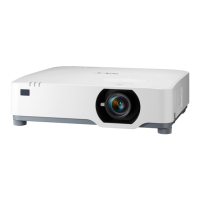4. Using On-Screen Menu
57
AdjustingColorTemperature[COLORTEMPERATURE]
Adjust the balance of the colors (R, G, B) to optimize the color reproducibility.
A color temperature with a high numerical value becomes bluish white while one with a low nu-
merical value becomes reddish white.
A value between 5000 K and 10500 K can be set in 100 K units.
NOTE:
• When[HIGH-BRIGHT]isselectedin[REFERENCE],thisfunctionisnotavailable.
AdjustingBrightnessandContrast[DYNAMICCONTRAST]
If [ON] is selected, the most optimal contrast ratio is used according to the picture.
NOTE:
• When[CONSTANTBRIGHTNESS]isactivated,[DYNAMICCONTRAST]cannotbeselected.
• Thisfunctionisnotavailablewhen[DICOMSIM.]isselectedfor[REFERENCE].
SelectingStillImageModeorMovieMode[IMAGEMODE]
This function allows you to select the still image mode or the movie mode.
STILL Thismodeisforastillimage.
MOVIE Thismodeisforamovie.
NOTE:
• Thisfunctionisavailableonlywhen[HIGH-BRIGHT]isselectedfor[REFERENCE].
EnhancingtheColor[COLORENHANCEMENT]
This allows you to adjust the color density of the image.
The color of the image will become deeper in the order of [LOW], [MEDIUM], and [HIGH] as the
displayed image will become darker.
With [OFF] selected, the [COLOR ENHANCEMENT] function will not work.
NOTE:
• Thisfunctionisnotavailablewhen[sRGB]or[DICOMSIM.]isselectedfor[REFERENCE].
AdjustingWhiteBalance[WHITEBALANCE]
This allows you to adjust the white balance. Contrast for each color (RGB) to adjust the white level
of the screen; Brightness for each color (RGB) is used to adjust the black level of the screen.
NOTE:
• When[WHITEBALANCE]isinoperation,theactualcolortonediersfromthevalueofthe[COLORTEMPERATURE].

